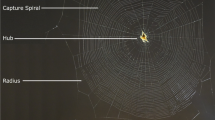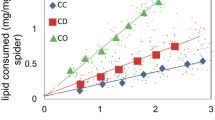Summary
Although spider webs may be effective in trapping prey, they require energy for construction. The design of webs varies in complexity from species to species. I assume that the energetic cost of web construction is significantly different among web types or species. This cost may constrain foraging tactics, particularly web relocation, because web relocation also requires energy to make a new web. To clarify the effect of the cost of web construction on web relocation, the energy cost of web construction and the rate of web relocation were estimated for the spider Agelena limbata. This spider constructs a sheet-funnel web consisting of a tight mesh of silk threads. This web was costly in terms of the energy needed for construction, which ranged from 9 to 19 times the daily maintenance energy. The daily rate of web relocation was below 1%, indicating high web-site tenacity. Relocation rates of species which built different types of web were compared in relation to cost of web construction. Orbweavers, which produce less costly webs than sheet-funnel weavers, relocate webs more frequently. Sheetweavers, which make webs of intermediate cost, appear to relocate webs more frequently than sheetfunnel weavers but less frequently than orbweavers. These results suggest that the energy cost of web construction is important in determining the frequency of web relocation.
Similar content being viewed by others
References
Anderson JF (1974) Responses to starvation in the spiders Lycosa lenta Hentz and Filistata hibernalis (Hentz). Ecology 55:576–585
Baskerville GL (1972) Use of logarithmic regression in the estimation of plant biomass. Can J Forest Res 2:49–53
Eberhard WG (1971) The ecology of the web of Uloborus diversus (Aranea: Uloboridae). Oecologia 6:328–342
Enders F (1975) Change of web site in Argiope spiders (Araneidae). Am Midl Nat 94:484–490
Foelix RF (1982) Biology of Spiders. Harvard University Press, Cambridge Massachusetts London
Ford MJ (1977) Energy costs of the predation strategy of the web-spinning spider Leptyphantes zimmermanni Bertkau (Linyphiidae). Oecologia 28:341–349
Janetos AC (1982) Foraging tactics of two guilds of web-spinning spiders. Behav Ecol Sociobiol 10:19–27
Lubin YD (1973) Web structure and function: The non-adhesive orb-web of Cyrtophora moluccensis (Doleschall) (Araneae: Araneidae). Forma et Functio 6:337–358
Olive CW (1982) Behavioral response of a sit-and-wait predator to spatial variation in foraging gain. Ecology 63:912–920
Peakall DB (1971) Conservation of web proteins in the spider, Araneus diadematus. J Exp Zool 176:257–264
Peakall DB, Witt PN (1976) The energy budget of an orb web-building spider. Comp Biochem Physiol 54A:187–190
Prestwich KN (1977) The energetics of web-building in spiders. Comp Biochem Physiol 57A:321–326
Riechert SE (1981) The consequences of being territorial: Spiders, a case study. Am Nat 117:871–892
Riechert SE (1982) Spider interaction strategies: Communication vs. coercion. In: Witt PN, Rovner JS (eds) Spider Communication: Mechanisms and Ecological Significance. Princeton University Press, Princeton New Jersey, pp 353–385
Riechert SE, Tracy CR (1975) Thermal balance and prey availability: Bases for a model relating web-site characteristics to spider reproductive success. Ecology 56:265–285
Rypstra AL (1981) The effect of kleptoparasitism on prey consumption of the spider Nephila clavipes. Oikos 37:179–182
Sprugel DG (1983) Correction for bias in log-transformed allometric equations. Ecology 64:209–210
Tanaka K, Itô Y (1982) Decrease in respiratory rate in a wolf spider, Pardosa astrigera (L. Koch), under starvation. Res Popul Ecol 24:360–374
Tanaka K, Saito T (1984) A method for the determination of respiratory quotient by gas chromatography. Appl Ent Zool 19:456–460
Tanaka K, Itô Y, Saito T (1985) Reduced respiratory quotient by starvation in a wolf spider, Pardosa astrigera (L. Koch). Comp Biochem Physiol 80A:415–418
Turnbull AL (1964) The search for prey by a web-building spider Achaearanea tepidariorum (C.L. Koch) (Araneae: Theridiidae). Can Ent 96:568–579
Author information
Authors and Affiliations
Rights and permissions
About this article
Cite this article
Tanaka, K. Energetic cost of web construction and its effect on web relocation in the web-building spider Agelena limbata . Oecologia 81, 459–464 (1989). https://doi.org/10.1007/BF00378952
Received:
Accepted:
Issue Date:
DOI: https://doi.org/10.1007/BF00378952




